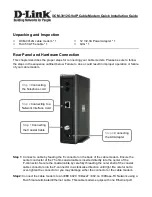
9
www.versitron.com
SECTION 3
OPERATION
3.1 INTRODUCTION
This chapter contains a description of the operating controls and indicators associated with
the Model F22XX FOM II series Modems. Since the Model F22XX is designed for continuous
and uninterrupted operation, there are no changes required during operation. Once powered up
the Model F22XX should remain in service as long as required.
3.2 STATUS INDICATORS
Five LED indicators on the Model F22XX FOM II products provide the operational status
of the unit. When illuminated, the green power (PWR) LED indicates that all DC power supply
voltages are present. The next indicator, labeled loop (LOOP) will illuminate when the optical
receiver detects an input. The transmit data (TX) and receive data (RX) indicators show the
presence of data activity. The red LED for loopback (LB) indicates that the circuit board is in
loopback mode when illuminated. There is no audible alarm with the F22XX Modems.
3.3 BIT RATE MONITOR
The bit-rate-monitor circuit measures the transmit clock period and is used to control the
code time base when the Modem is in the automatic mode. At low clock rates, or when no clock
is present, the unit selects an internal 10 MHz oscillator as the code time base. This high
sampling rate minimizes jitter caused by sampling within the transmit circuit. At higher clock
rates, the transmit clock itself is selected as the code time base. This has the advantage that the
code is synchronous with the transmitted data, so there is no sampling-induced jitter.
When the input data rate increases from below 50 Kbps, the bit-rate-monitor circuit will
switch from the 10 MHz oscillator to the transmit clock at a data rate of about 120 Kbps. It will
switch in the opposite direction when the data rate falls below about 60 Kbps. The hysteresis in
the switching circuit protects against the modem switching time bases incorrectly if operating
close to the switching threshold.
3.4 CLOCK SELECT OPTIONS
The only controls with the Model F22XX FOM II Series Modems are those jumpers that
configure the operation in one of three modes: Automatic, Forced Synchronous, and Forced
Asynchronous. The Automatic mode is appropriate for use with full duplex data transmission.
One of the two Forced modes should be used if the transmit and received sections of the circuit
board are operated independently of each other. The jumper settings are described in Section 2.4
and selection is normally done at the time of installation. Further changes are not required
unless the overall system requirements change.
SECTION 4

































